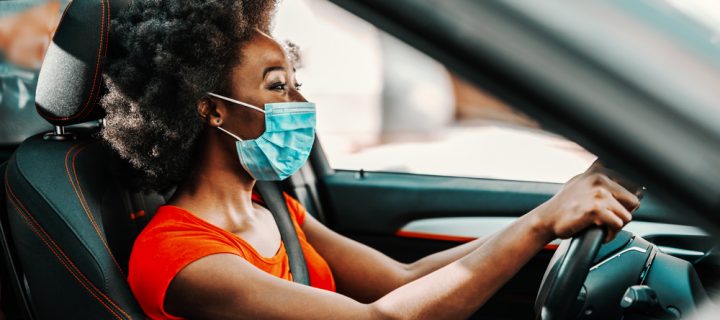Put certain windows down and keep the heat and AC off.
A lot of us need to travel in a car on a daily basis. From getting to work, (if you still have a job and need to go outside your home to get to it), to buying groceries, purchasing holiday gifts, getting to medical appointments, and finding someplace to relax outside, four wheels can be a necessity. Not everyone owns their own car, however. And public transportation in the form of buses and subways isn’t always available.
The problem, of course, is that sharing a car such as a taxi or an Uber with people outside your immediate household can place you at a definite risk for catching COVID-19. Cars are tiny, enclosed spaces. You often spend more than 15 minutes in them, and social distancing there just isn’t possible. The result? This provides a near-perfect petri dish in which to spread COVID-19. This is because aerosols, or tiny liquid droplets that we exhale, can linger in the air of a car. Exposure to infected aerosols is thought to be one of the ways in which you can catch COVID-19.
What can you do to protect yourself? Your best line of defence is to stay away from shared vehicles during the pandemic. It’s a no-brainer. If you must get inside one, researchers at Brown University have a few tips for reducing your coronavirus risk.
Open the Windows
Yes, it’s almost the end of 2020 and we are in the deep dark depths of winter. It’s cold. You still might want to do this, however. Researchers found that rolling down your car windows can really help reduce your chances of catching COVID-19 in a shared car.
To do this, a team of scientists from Brown University used computer models to simulate how air flows inside a compact car. They studied what happens when two people are driving in a car similar in size and design to a Toyota Prius. One person was modeled driving and the other, riding as a passenger in the back seat. The car was modeled moving at 50 miles per hour, and studies were done with the windows both open and closed.
Not surprisingly, it was found that having your car windows open can really help.
How? Rolling down the windows this creates airflow patterns that greatly reduce the concentration of airborne particles passing between the driver and one backseat passenger. The number of air changes in the vehicle per hour goes up with the windows down, and this in turn reduces the general concentration of aerosols in the immediate environment.
Which windows should you open for the best results? Read on.
Go for Opposites
Opening all your four windows was found to reduce the concentration of aerosols in the car the most. And some windows are better at doing this than others.
The study showed that lowering the window opposite a person, rather than immediately beside them, is best. Lowering the windows right beside each occupant provided a higher exposure risk than lowering the windows opposite each person.
“When the windows opposite the occupants are open, you get a flow that enters the car behind the driver, sweeps across the cabin behind the passenger and then goes out the passenger-side front window,” said Kenny Breuer, a professor of engineering at Brown and lead author of the study. “That pattern helps to reduce cross-contamination between the driver and passenger”.
Keep the Heat or AC Off
Yes, it’s bad news in December and January, but unfortunately, cranking up your car’s ventilation won’t really help. In fact, turning it on can be a terribly dangerous thing to do.
“Driving around with the windows up and the air conditioning or heat on is definitely the worst scenario, according to our computer simulations,” said Asimanshu Das, a graduate student in Brown’s School of Engineering who co-lead the research.
According to Das, your safest bet is to keep all four windows open. If you can’t do that, one or two open is better than none.
If you can, postpone your travel until after the pandemic is over, as the U.S Centers for Disease Control and Prevention (CDC) encourages. This is ultimately the best way to protect yourself and your community when it comes to traveling in a vehicle during the pandemic.
Can’t do this? Rent a stretched limo, bundle up, and cross your fingers, (if they aren’t frozen too much to move).
photo credits: Dusan Petkovic/Shutterstock.com












